Scalable Fabrication of Nanogratings on GaP for Efficient Diffraction of Near-Infrared Pulses and Enhanced Terahertz Generation by Optical Rectification
Abstract
:1. Introduction
2. Fabrication Process and Results
3. Optical and Terahertz Measurement
4. Conclusions
Author Contributions
Funding
Institutional Review Board Statement
Informed Consent Statement
Data Availability Statement
Acknowledgments
Conflicts of Interest
References
- Seisyan, R.P. Nanolithography in Microelectronics: A Review. Tech. Phys. 2011, 56, 1061–1073. [Google Scholar] [CrossRef]
- Ross, C.A.; Smith, H.I.; Savas, T.; Schattenburg, M.; Farhoud, M.; Hwang, M.; Walsh, M.; Abraham, M.C.; Ram, R.J. Fabrication of patterned media for high density magnetic storage. J. Vac. Sci. Technol. B Microelectron. Nanom. Struct. 1999, 17, 3168. [Google Scholar] [CrossRef]
- Nayak, P.K.; Mahesh, S.; Snaith, H.J.; Cahen, D. Photovoltaic Solar Cell Technologies: Analysing the State of the Art. Nat. Rev. Mater. 2019, 4, 269–285. [Google Scholar] [CrossRef]
- Sezer, N.; Koç, M. A Comprehensive Review on the State-of-the-Art of Piezoelectric Energy Harvesting. Nano Energy 2021, 80, 105567. [Google Scholar] [CrossRef]
- Halpin, A.; Cui, W.; Schiff-Kearn, A.W.; Awan, K.M.; Dolgaleva, K.; Ménard, J.-M. Enhanced Terahertz Detection Efficiency via Grating-Assisted Noncollinear Electro-Optic Sampling. Phys. Rev. Appl. 2019, 12, 31003. [Google Scholar] [CrossRef]
- Cui, W.; Awan, K.M.; Huber, R.; Dolgaleva, K.; Ménard, J.-M. Broadband and High-Sensitivity Time-Resolved THz System Using Grating-Assisted Tilted-Pulse-Front Phase Matching. Adv. Opt. Mater. 2022, 10, 2101136. [Google Scholar] [CrossRef]
- Abasahl, B.; Santschi, C.; Raziman, T.V.; Martin, O.J.F. Fabrication of Plasmonic Structures with Well-Controlled Nanometric Features: A Comparison between Lift-off and Ion Beam Etching. Nanotechnology 2021, 32, 475202. [Google Scholar] [CrossRef]
- Krause, B.; Pham, M.T.; Luong, H.M.; Nguyen, T.D.; Hoang, T.B. Periodic Nanohole Arrays with Enhanced Lasing and Spontaneous Emissions for Low-Cost Plasmonic Devices. ACS Appl. Nano Mater. 2022, 5, 1185–1191. [Google Scholar] [CrossRef]
- Northfield, H.; Krupin, O.; Tait, R.N.; Berini, P. Tri-Layer Contact Photolithography Process for High-Resolution Lift-Off. Microelectron. Eng. 2021, 241, 111545. [Google Scholar] [CrossRef]
- Zheng, L.; Zywietz, U.; Birr, T.; Duderstadt, M.; Overmeyer, L.; Roth, B.; Reinhardt, C. UV-LED Projection Photolithography for High-Resolution Functional Photonic Components. Microsyst. Nanoeng. 2021, 7, 64. [Google Scholar] [CrossRef]
- Levinson, H.J. Principles of Lithography; SPIE Press: Bellingham, MA, USA, 2005; Volume 146, ISBN 0819456608. [Google Scholar]
- Neisser, M. International Roadmap for Devices and Systems Lithography Roadmap. J. Micro/Nanopatterning Mater. Metrol. 2021, 20, 044601. [Google Scholar] [CrossRef]
- Stuerzebecher, L.; Fuchs, F.; Zeitner, U.D.; Tuennermann, A. High-Resolution Proximity Lithography for Nano-Optical Components. Microelectron. Eng. 2015, 132, 120–134. [Google Scholar] [CrossRef]
- van Assenbergh, P.; Meinders, E.; Geraedts, J.; Dodou, D. Nanostructure and Microstructure Fabrication: From Desired Properties to Suitable Processes. Small 2018, 14, 1703401. [Google Scholar] [CrossRef] [PubMed]
- Wu, C.-Y.; Hsieh, H.; Lee, Y.-C. Contact Photolithography at Sub-Micrometer Scale Using a Soft Photomask. Micromachines 2019, 10, 547. [Google Scholar] [CrossRef] [Green Version]
- Samoila, C.; Ursutiu, D.; Tavkhelidze, A.; Jangidze, L.; Taliashvili, Z.; Skhiladze, G.; Tierean, M. Nanograting Layers of Si. Nanotechnology 2020, 31, 035301. [Google Scholar] [CrossRef]
- Qiao, W.; Pu, D.; Chen, L.-S. Nanofabrication Toward High-Resolution and Large Area. In Proceedings of the 2021 IEEE 34th International Conference on Micro Electro Mechanical Systems (MEMS), Gainesville, FL, USA, 25–29 January 2021; pp. 42–46. [Google Scholar]
- Tallents, G.; Wagenaars, E.; Pert, G. Lithography at EUV Wavelengths. Nat. Photonics 2010, 4, 809–811. [Google Scholar] [CrossRef]
- Levenson, M.D.; Viswanathan, N.S.; Simpson, R.A. Improving Resolution in Photolithography with a Phase-Shifting Mask. IEEE Trans. Electron Devices 1982, 29, 1828–1836. [Google Scholar] [CrossRef]
- Luo, R. Optical Proximity Correction Using a Multilayer Perceptron Neural Network. J. Opt. 2013, 15, 75708. [Google Scholar] [CrossRef]
- Sugawara, M.; Chiba, A.; Nishiyama, I. Effect of Incident Angle of Off-Axis Illumination on Pattern Printability in Extreme Ultraviolet Lithography. J. Vac. Sci. Technol. B Microelectron. Nanom. Struct. Process. Meas. Phenom. 2003, 21, 2701–2705. [Google Scholar] [CrossRef]
- Voelkel, R.; Vogler, U.; Bich, A.; Pernet, P.; Weible, K.J.; Hornung, M.; Zoberbier, R.; Cullmann, E.; Stuerzebecher, L.; Harzendorf, T.; et al. Advanced Mask Aligner Lithography: New Illumination System. Opt. Express 2010, 18, 20968. [Google Scholar] [CrossRef]
- Kim, Y.U.; Kwon, N.Y.; Park, S.H.; Kim, C.W.; Chau, H.D.; Hoang, M.H.; Cho, M.J.; Choi, D.H. Patterned Sandwich-Type Silver Nanowire-Based Flexible Electrode by Photolithography. ACS Appl. Mater. Interfaces 2021, 13, 61463–61472. [Google Scholar] [CrossRef] [PubMed]
- Liu, Z.; Yang, Z.; Wang, W.; Yang, Q.; Han, Q.; Ma, D.; Cheng, H.; Lin, Y.; Zheng, J.; Liu, W. Numerical and Experimental Exploration towards a 26% Efficiency Rear-Junction n-Type Silicon Solar Cell with Front Local-Area and Rear Full-Area Polysilicon Passivated Contacts. Sol. Energy 2021, 221, 1–9. [Google Scholar] [CrossRef]
- Yang, J.; Lin, Y.-S. Design of Tunable Terahertz Metamaterial Sensor with Single-and Dual-Resonance Characteristic. Nanomaterials 2021, 11, 2212. [Google Scholar] [CrossRef]
- Laguna, A.P.; Karatsu, K.; Thoen, D.J.; Murugesan, V.; Buijtendorp, B.T.; Endo, A.; Baselmans, J.J.A. Terahertz Band-Pass Filters for Wideband Superconducting On-Chip Filter-Bank Spectrometers. IEEE Trans. Terahertz Sci. Technol. 2021, 11, 635–646. [Google Scholar] [CrossRef]
- Nikolaidou, K.; Oliveira, H.M.; Cardoso, S.; Freitas, P.P.; Chu, V.; Conde, J.P. Monolithic Integration of Multi-Spectral Optical Interference Filter Array on Thin Film Amorphous Silicon Photodiodes. IEEE Sens. J. 2022, 22, 5636–5643. [Google Scholar] [CrossRef]
- Jonker, D.; Jafari, Z.; Winczewski, J.P.; Eyovge, C.; Berenschot, J.W.; Tas, N.R.; Gardeniers, J.G.E.; De Leon, I.; Susarrey-Arce, A. A Wafer-Scale Fabrication Method for Three-Dimensional Plasmonic Hollow Nanopillars. Nanoscale Adv. 2021, 3, 4926–4939. [Google Scholar] [CrossRef]
- Liu, G.-S.; Wang, T.; Wang, Y.; Zheng, H.; Chen, Y.; Zeng, Z.; Chen, L.; Chen, Y.; Yang, B.-R.; Luo, Y. One-Step Plasmonic Welding and Photolithographic Patterning of Silver Nanowire Network by UV-Programable Surface Atom Diffusion. Nano Res. 2021, 15, 2582–2591. [Google Scholar] [CrossRef]
- Yoo, D.; Barik, A.; de Leon-Perez, F.; Mohr, D.A.; Pelton, M.; Martín-Moreno, L.; Oh, S.-H. Plasmonic Split-Trench Resonator for Trapping and Sensing. ACS Nano 2021, 15, 6669–6677. [Google Scholar] [CrossRef]
- Yang, J.; Wang, C. Efficient Terahertz Generation Scheme in a Thin-Film Lithium Niobate-Silicon Hybrid Platform. Opt. Express 2021, 29, 16477–16486. [Google Scholar] [CrossRef]
- Dong, T.; Li, S.; Manjappa, M.; Yang, P.; Zhou, J.; Kong, D.; Quan, B.; Chen, X.; Ouyang, C.; Dai, F. Nonlinear THz-Nano Metasurfaces. Adv. Funct. Mater. 2021, 31, 2100463. [Google Scholar] [CrossRef]
- Wang, P.; Hu, R.; Huang, X.; Wang, T.; Hu, S.; Hu, M.; Xu, H.; Li, X.; Liu, K.; Wang, S. Terahertz Chiral Metamaterials Enabled by Textile Manufacturing. Adv. Mater. 2022, 34, 2110590. [Google Scholar] [CrossRef] [PubMed]
- Václavík, J.; Vápenka, D. Gallium Phosphide as a Material for Visible and Infrared Optics. EPJ Web Conf. 2013, 48, 28. [Google Scholar] [CrossRef] [Green Version]
- Martin, A.; Combrié, S.; de Rossi, A.; Beaudoin, G.; Sagnes, I.; Raineri, F. Nonlinear Gallium Phosphide Nanoscale Photonics. Photonics Res. 2018, 6, B43–B49. [Google Scholar] [CrossRef]
- Wilson, D.J.; Schneider, K.; Hönl, S.; Anderson, M.; Baumgartner, Y.; Czornomaz, L.; Kippenberg, T.J.; Seidler, P. Integrated gallium phosphide nonlinear photonics. Nat. Photonics 2020, 14, 57–62. [Google Scholar] [CrossRef] [Green Version]
- Cui, W.; Schiff-Kearn, A.W.; Zhang, E.; Couture, N.; Tani, F.; Novoa, D.; Russell, P.S.J.; Ménard, J.-M. Broadband and TunableTime-Resolved THz System Using Argon-Filled Hollow-Core Photonic Crystal Fiber. APL Photonics 2018, 3, 111301. [Google Scholar] [CrossRef] [Green Version]
- Paradis, C.; Drs, J.; Modsching, N.; Razskazovskaya, O.; Meyer, F.; Kränkel, C.; Saraceno, C.J.; Wittwer, V.J.; Südmeyer, T. Broadband terahertz pulse generation driven by an ultrafast thin-disk laser oscillator. Opt. Express 2018, 26, 26377–26384. [Google Scholar] [CrossRef] [Green Version]
- Yeh, W.-M.; Lawson, R.A.; Tolbert, L.M.; Henderson, C.L. A Study of Reactive Adhesion Promoters and Their Ability to Mitigate Pattern Collapse in Thin Film Lithography. In Proceedings of the Advances in Resist Materials and Processing Technology XXVIII, SPIE Advanced Lithography, San Jose, CA, USA, 27 February–3 March 2011; Volume 7972, pp. 534–540. [Google Scholar]
- Partel, S.; Kasemann, S.; Choleva, P.; Dincer, C.; Kieninger, J.; Urban, G.A. Novel Fabrication Process for Sub-Micron Interdigitated Electrode Arrays for Highly Sensitive Electrochemical Detection. Sensors Actuators B Chem. 2014, 205, 193–198. [Google Scholar] [CrossRef]
- Toukhy, M.A.; Hansen, S.G. Influence of Post Exposure Bake on Resist Contrast. In Proceedings of the Advances in Resist Technology and Processing XI, SPIE’S 1994 Symposium on Microlithography, San Jose, CA, USA, 27 February–4 March 1994; Volume 2195, pp. 640–651. [Google Scholar]
- Booker, K.; Mayon, Y.O.; Jones, C.; Stocks, M.; Blakers, A. Deep, Vertical Etching for GaAs Using Inductively Coupled Plasma/Reactive Ion Etching. J. Vac. Sci. Technol. B 2020, 38, 012206. [Google Scholar] [CrossRef]
- Nakayama, D.; Wada, A.; Kubota, T.; Bruce, R.; Martin, R.M.; Haass, M.; Fuller, N.; Samukawa, S. Highly Selective Silicon Nitride Etching to Si and SiO2 for a Gate Sidewall Spacer Using a CF3I/O2/H2 Neutral Beam. J. Phys. D. Appl. Phys. 2013, 46, 205203. [Google Scholar] [CrossRef]
- Boyd, R.W. Nonlinear Optics; Academic Press: Cambridge, MA, USA, 2020; ISBN 0128110031. [Google Scholar]
- Pálfalvi, L.; Fülöp, J.A.; Almási, G.; Hebling, J. Novel Setups for Extremely High Power Single-Cycle Terahertz Pulse Generation by Optical Rectification. Appl. Phys. Lett. 2008, 92, 171107. [Google Scholar] [CrossRef]
- Nagashima, K.; Kosuge, A. Design of Rectangular Transmission Gratings Fabricated in LiNbO3 for High-Power Terahertz-Wave Generation. Jpn. J. Appl. Phys. 2010, 49, 122504. [Google Scholar] [CrossRef]
- Ollmann, Z.; Fülöp, J.A.; Hebling, J.; Almási, G. Design of a high-energy terahertz pulse source based on ZnTe contact grating. Optics Commun. 2014, 315, 159. [Google Scholar] [CrossRef]
- Yoshida, F.; Nagashima, K.; Tsubouchi, M.; Maruyama, M.; Ochi, Y. THz pulse generation using a contact grating device composed of TiO2 /SiO2 thin films on LiNbO3 crystal. J. Appl. Phys. 2016, 120, 183103. [Google Scholar] [CrossRef]
- Fülöp, J.A.; Polónyi, G.; Monoszlai, B.; Andriukaitis, G.; Balciunas, T.; Pugzlys, A.; Arthur, G.; Baltuska, A.; Hebling, J. Highly efficient scalable monolithic semiconductor terahertz pulse source. Optica 2016, 3, 1075. [Google Scholar] [CrossRef] [Green Version]
- Bakunov, M.I.; Bodrov, S.B. Terahertz generation with tilted-front laser pulses in a contact-grating scheme. J. Opt. Soc. Am. B 2014, 31, 2549. [Google Scholar] [CrossRef]
- Nugraha, P.S.; Krizsán, G.; Polónyi, G.; Mechler, M.I.; Hebling, J.; Tóth, G.; Fülöp, J.A. Efficient semiconductor multicycle terahertz pulse source. J. Phys. B At. Mol. Opt. Phys. 2018, 51, 94007. [Google Scholar] [CrossRef]
- Harvey, J.E.; Pfisterer, R.N. Understanding diffraction grating behavior: Including conical diffraction and Rayleigh anomalies from transmission gratings. Opt. Eng. 2019, 58, 087105. [Google Scholar] [CrossRef]
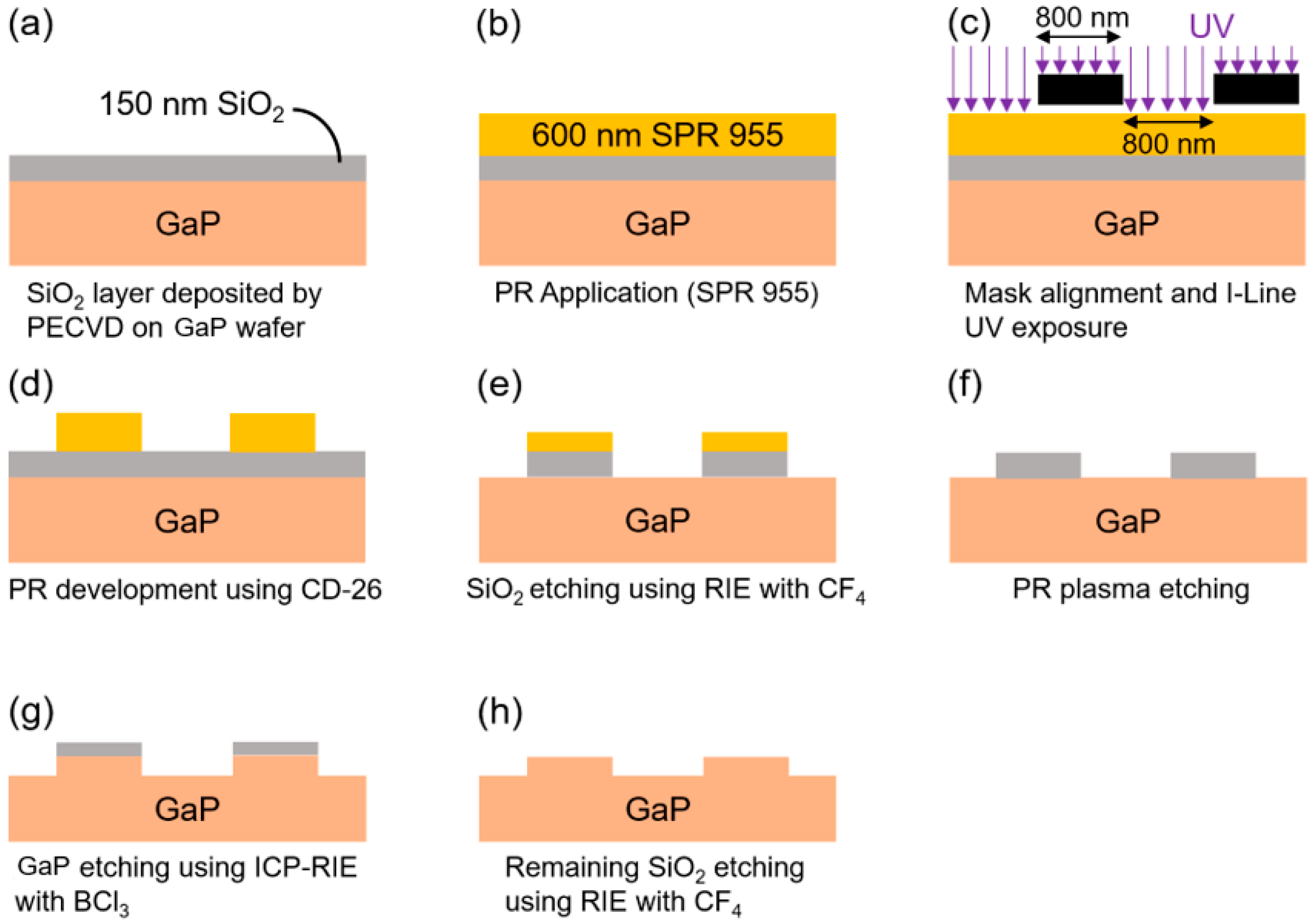
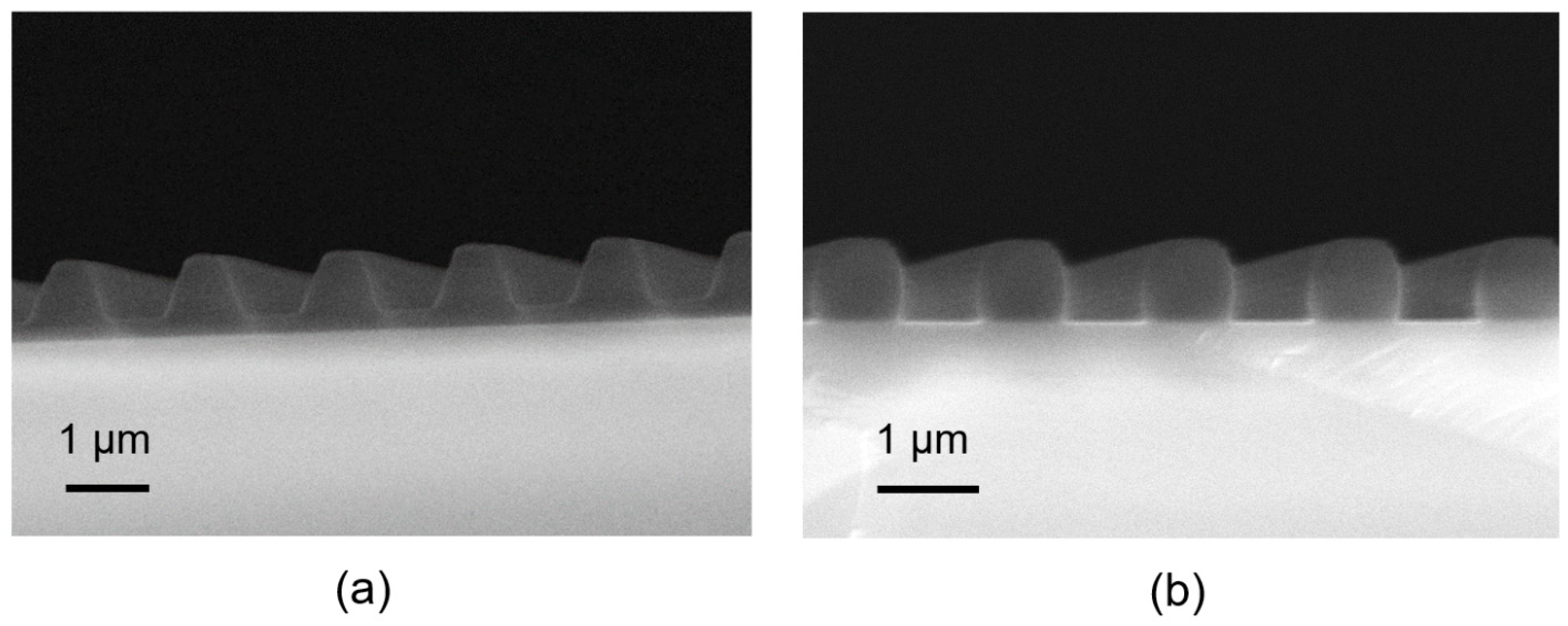
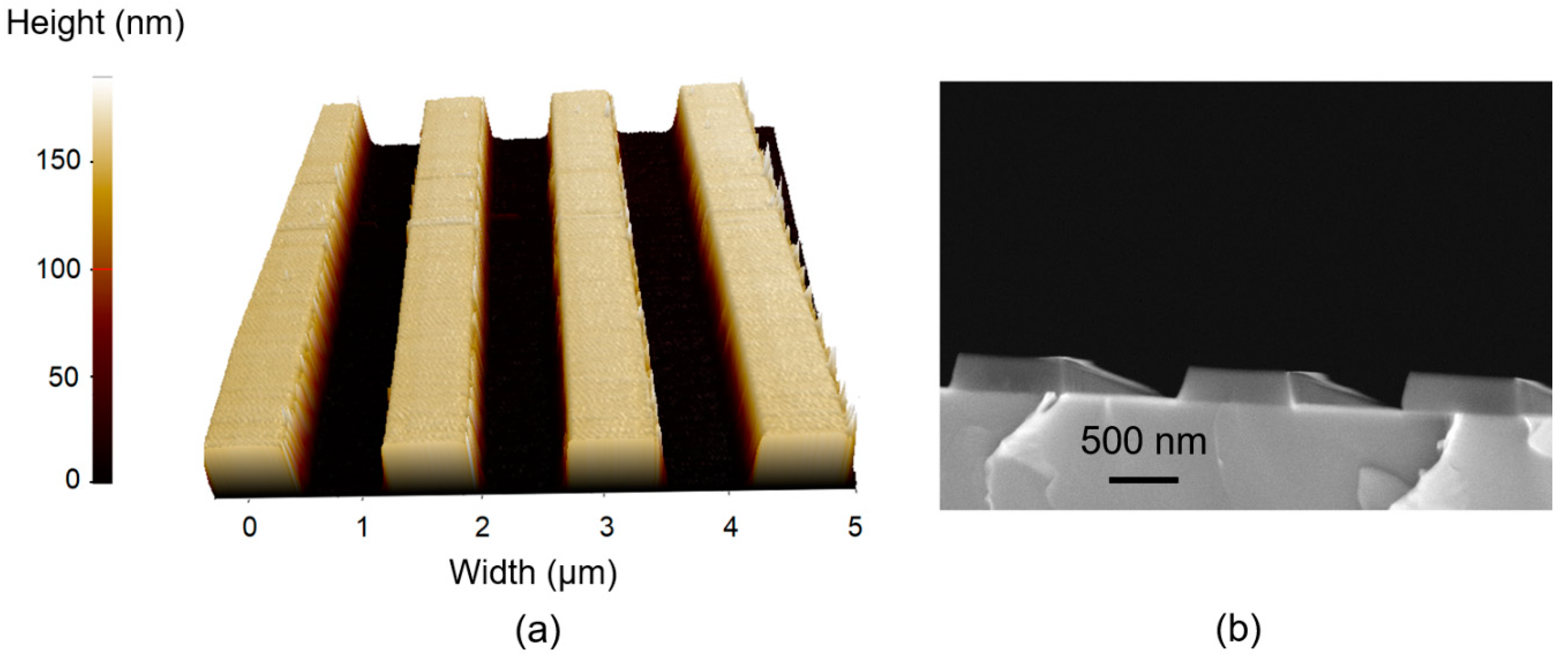
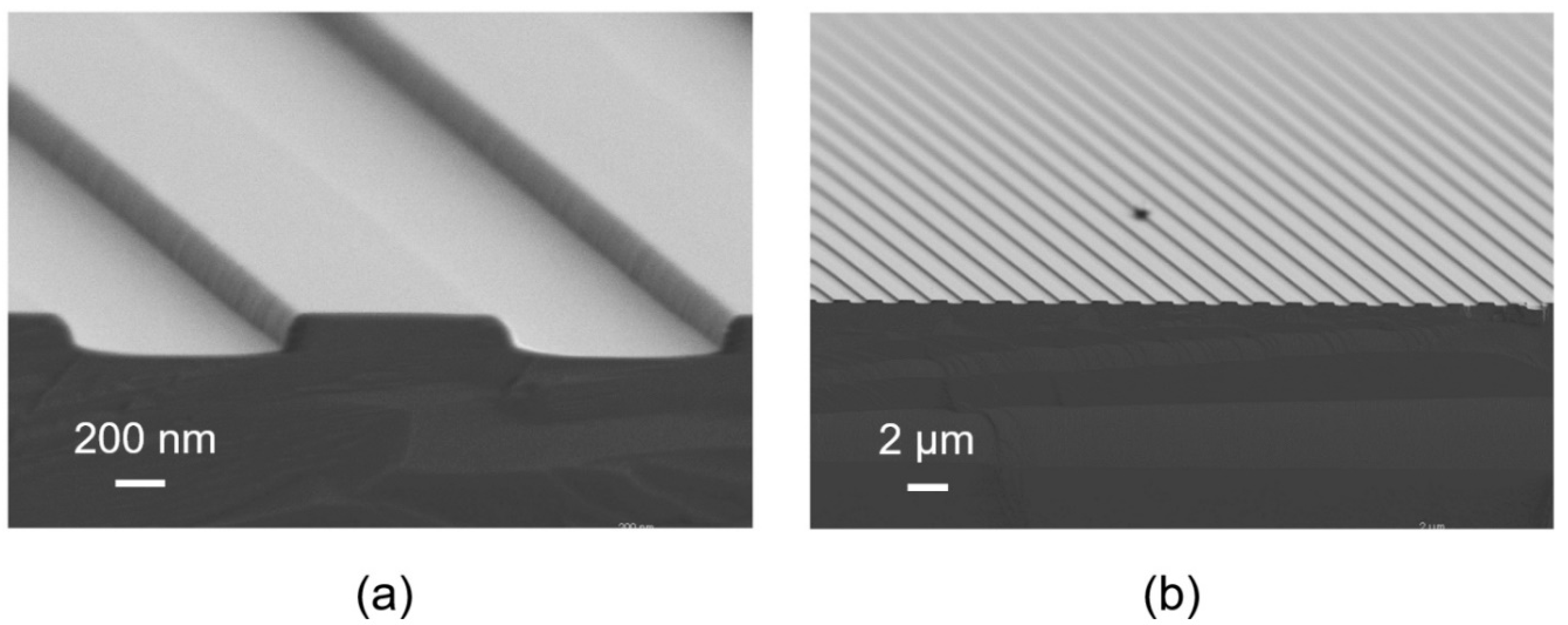
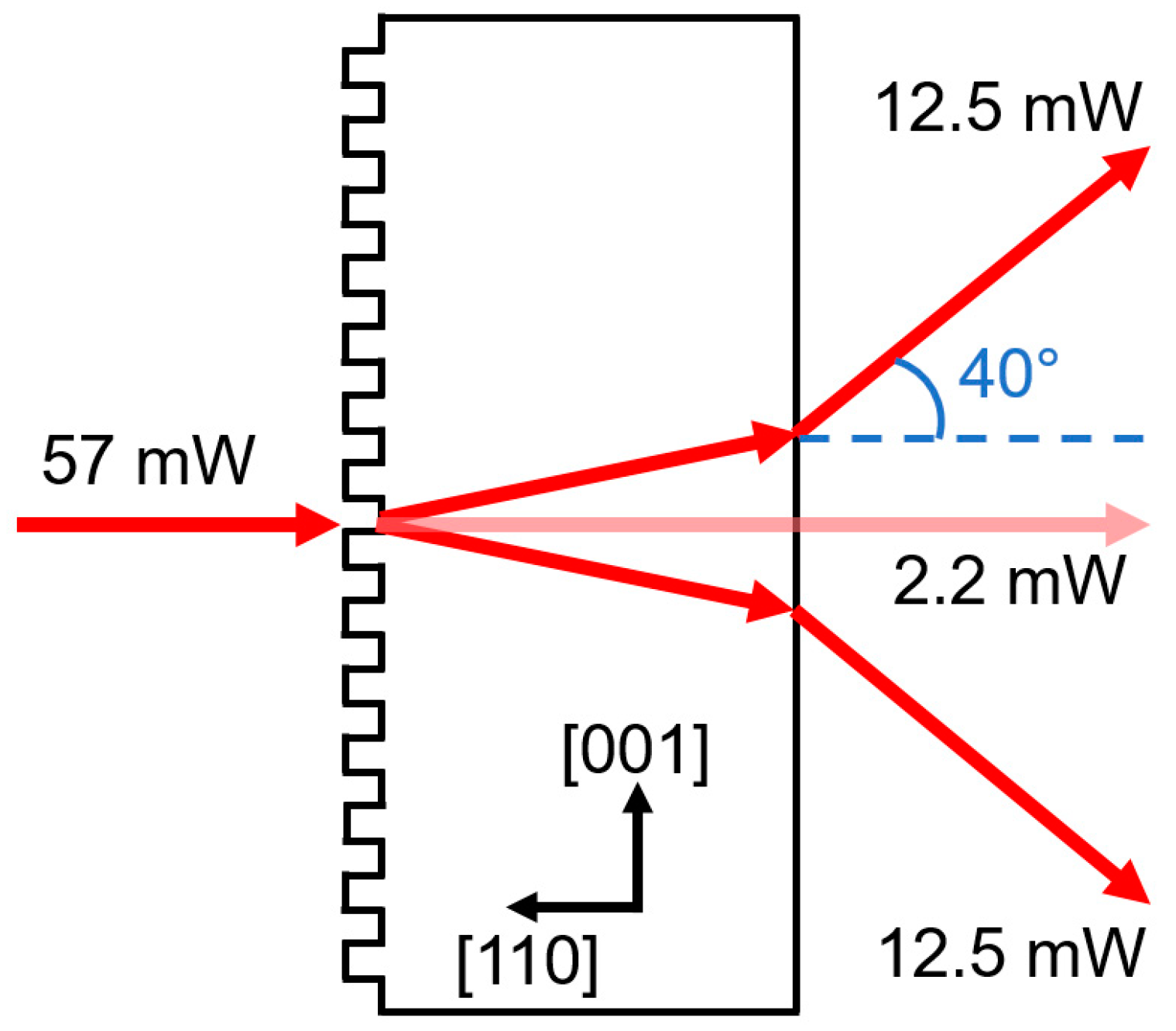

| Step | Description | Details |
|---|---|---|
| 1 | Wafer cleaning | Cleaning with acetone, IPA, and DI water in ultrasonic bath. |
| 2 | SiO2 deposition | 150 nm SiO2 deposition by PECVD system at 300 °C. |
| 3 | Apply HMDS layer | HMDS vapor deposition in oven at 90 °C during 5 min. |
| 4 | SPR955 application | Spin coating of photoresist (15 s at 200 r/s) + (30 s at 3000 rpm) + (15 s at 200 r/s) + (30 s at 6000 rpm) + (30 s at −200 rpm/s, reducing the speed from 6000 rpm to 0 rpm). |
| 5 | Prebake | 1 min at 100 °C on hotplate. |
| 6 | UV exposure | 145 mJ/cm2 dosage with i-line |
| 7 | Post exposure bake | 2 min at 115 °C on hotplate |
| 8 | Photoresist development | 12 s in CD-26 followed by DI water bath and nitrogen blow dry. |
| 9 | Hardening bake | 10 min at 135 °C on hotplate |
| 10 | RIE of SiO2 | SAMCO 10-NR: CF4: 40 SCCM, power: 100 W, pressure: 3 Pa, time: 5 min |
| 11 | Photoresist stripping | 10 SCCM, power: 25 W, pressure: 5 pa, time: 10 min |
| 12 | ICP-RIE of GaP nanograting | SAMCO 110ip: BCl3: 2.5 SCCM, ICP power: 50 W, bias power: 25 W, Pressure: 0.15 Pa, temperature: 25 °C, time: 4 min 20 s |
| 13 | Etching remained SiO2 by RIE | SAMCO 10-NR: CF4: 40 SCCM, power: 100 W, pressure: 3 Pa, time:3 min |
| 14 | Dicing the wafer | Dicing the wafer to obtain desired sample sizes |
Publisher’s Note: MDPI stays neutral with regard to jurisdictional claims in published maps and institutional affiliations. |
© 2022 by the authors. Licensee MDPI, Basel, Switzerland. This article is an open access article distributed under the terms and conditions of the Creative Commons Attribution (CC BY) license (https://creativecommons.org/licenses/by/4.0/).
Share and Cite
Bashirpour, M.; Cui, W.; Gamouras, A.; Ménard, J.-M. Scalable Fabrication of Nanogratings on GaP for Efficient Diffraction of Near-Infrared Pulses and Enhanced Terahertz Generation by Optical Rectification. Crystals 2022, 12, 684. https://doi.org/10.3390/cryst12050684
Bashirpour M, Cui W, Gamouras A, Ménard J-M. Scalable Fabrication of Nanogratings on GaP for Efficient Diffraction of Near-Infrared Pulses and Enhanced Terahertz Generation by Optical Rectification. Crystals. 2022; 12(5):684. https://doi.org/10.3390/cryst12050684
Chicago/Turabian StyleBashirpour, Mohammad, Wei Cui, Angela Gamouras, and Jean-Michel Ménard. 2022. "Scalable Fabrication of Nanogratings on GaP for Efficient Diffraction of Near-Infrared Pulses and Enhanced Terahertz Generation by Optical Rectification" Crystals 12, no. 5: 684. https://doi.org/10.3390/cryst12050684






